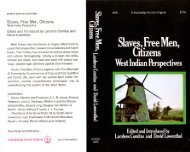e - CIFAS
e - CIFAS
e - CIFAS
You also want an ePaper? Increase the reach of your titles
YUMPU automatically turns print PDFs into web optimized ePapers that Google loves.
56 GOVERNMENT IN ZAZZAU<br />
staff, and in consequence of this they lacked internal or external<br />
segmentary relations.<br />
Our data indicate the existence of two other specialized ad~<br />
ministrative ordersj firstly, the king's slaves, among whom were<br />
groups distinguished in terms of military, civil, and police duties;<br />
and secondly, the religious order of mallams, who officiated at<br />
rituals andwho advised technically onthe contentandapplication of<br />
Mubammadan law. Significantly also, both these orders. the mallams<br />
and the slaves. lacked any internal eegmentation or external<br />
contraposition with other groups, and were distinguished by<br />
particular lines of communication with the king. Thus the king<br />
communicated with each mallam individually through his chamber<br />
eunuchs, while the supervision of military and civil groups of<br />
slaves was carried out for the Madawaki by the Sata, himself a<br />
promoted slave, and for the Sarkin Fada, by the Hauni, with<br />
consequent political neutralization of this order, while the police<br />
and town-guard were separately controlled by the Gaiadima.<br />
Positively, in the specification of their duties and in the allocation<br />
of means and authority for their execution, and negatively, by<br />
their exclusion from the processes of policy formation, these two<br />
orders, the slaves and the mallams, and the various offices which<br />
separately constitute them, exhibit a purely administrative<br />
character. Their exclusion from the system of political action is<br />
evident in two ways: firsdy, by the incompatibility of their roles<br />
with political office, from which the slaves and the mallams were<br />
by definition excluded 80long as theyremainedslaves andmallarns;<br />
secondly, by their insulation from political influence and appoint~<br />
ments due to the status requisites applying in either case. Further~<br />
more, as pointed out above, these orders exhibit no internal or<br />
external segmentary relations. Thus. although the order of slave~<br />
officials was internally divided into functional groups, none of these<br />
divisions had a head or hierarchic internal organization.<br />
The order of mallams is of special interest, as it furnished the<br />
majority ofthe electoral council entrusted with the selection ofthe<br />
king's successor. This function might suggest that this order had a<br />
political character; but on this point, fortunately, the data are very<br />
clear. Together with the Madawaki and the senior eunu~<br />
Galadima, three malLams were authorized and required to select<br />
the new king; but, unlike the two public ofiiciaIs with whom they<br />
were associated, after deciding the succession, the authority and<br />
GOVERNMENT IN NINETEENTH-CENTURY ABUJA 57<br />
responsibility of theee malLatn8 was exhausted, and they retired<br />
from the political scene, back to their religious duties. It is thus<br />
quite clear that the electoral malJams, though authorized to select<br />
the ruler, were otherwise excluded from the policy-making process,<br />
and that in selecting the ruler they were held to be carrying<br />
out an authorized, that is, an administrative task. This indeed explains<br />
their presence as the majority group on the electoral council.<br />
Mallams were given numerical dominance on this council in order<br />
to out-vote its purely political elementj to minimize the threat<br />
which succession presented to the continuity of the system; by<br />
their religious prestige, to legitimize the new ruler's appointment;<br />
to frustrate the nomination of persons whose incapacity for the<br />
throne would give their political nominators opportunities for the<br />
improper exercise and appropriation of power; and to select the<br />
most suitable candidate with the minimum of political bargaining.<br />
(i') TIw Nature of Office<br />
An analysis of the segmentary aspects of the Ahuja government<br />
directs attention to the nature of the units of the system. These<br />
units are offices, which were defined as perpetual and exclusive<br />
statuses in a system consisting of such statuses and their inter~<br />
relations. In the definition of any particular office, or of office<br />
generally, the relations between each unit and other members of<br />
the system forms a very important part. The position of an office<br />
within the system really consists in its relations to other parts of<br />
the system. But this does not fully describe the office, nor exhaust<br />
its meaning. Offices were differentiated politically and administratively,<br />
as we have just seenj and those different types of office had<br />
different types of relation with the society at large. Although the<br />
functions of office were governmental, these functions were not<br />
entirely confined to the system ofoffices. itself, and their execution<br />
brought offices of this system into contact with the society at<br />
large.<br />
The offices of a governmental system and their interrelations together<br />
fonn its structure, while the activities of these units<br />
constitute its function. We can therefore distinguish between the<br />
structure of the syStem of government on the one hand, and the<br />
functions of the system or its constituent offices on the other. We<br />
must also distinguish between administrative relations by which<br />
government controls the society and conducts its affairs, and





